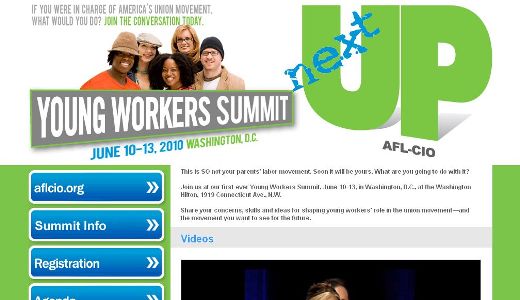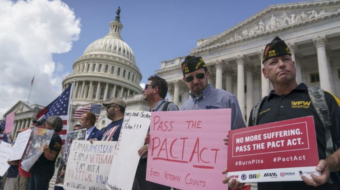
WASHINGTON (PAI)–In a scene that one postal worker from Chicago said was unlike any other union conclave he ever attended, more than 300 young union activists from around the country sharply quizzed top AFL-CIO leaders and started planning their own networking, organizing and communications campaigns.
The delegates, to the AFL-CIO’s first-ever Next Up Young Workers Summit told the fed’s top leaders that unions must change and respond to a changing workforce, changing work habits and different priorities. Communication, they added, must both use social networking — such as Twitter, YouTube and other technologies — and must be 2-way as well, not just top-down.
The summit, organized by federation Secretary-Treasurer Liz Shuler, who herself is 39, was called to try to figure out how to reach out to younger workers. Federal data show that organized labor is older than the workforce in general. One of every six workers aged 45-64 is a union member. Only one of every 20 aged 18-24 is in a union.
The June 10-13 conference was unusual for the union movement: Shuler, fed President Richard Trumka and Executive Vice President Arlene Holt Baker spoke, but kept their remarks short. They were there, they said, to listen. They got an earful.
Many younger workers nationwide don’t even know what unions are, some delegates said. One asked Trumka why the federation has no Education Department. He replied it was to have been folded into the National Labor College. A Teamster from New York said the movement must reunite nationally “as we have” locally in New York.
Marsha McCurdy of West Hartford, Conn., the only firefighter, described how her local “worked on re-branding — getting the word out about who unions are.” George Gott, a steelworker from Youngstown, said “we gotta be a pest in our workplace.”
Others emphasized reaching out to unorganized workers, even incorporating them into AFL-CIO conferences. One suggested there are many simple ways of teaching people about unions, such as volunteering for a community service project — like painting a school — and showing up with your union t-shirt on. That would prompt questions, and the chance for the unionist to talk about the union advantage.
And many delegates emphasized enormous and continuous outreach to non-union allies in community groups, religious groups and other activist. Arrange union- sponsored events and invite them all, then get back to them afterwards for feedback –“Did you like it? What else could we do?” — so that, when the time comes for the unions to seek the outsiders’ support, it will automatically be there.
Still others said the union movement must become relevant to young workers by trumpeting achievements “that have happened within our lifetimes.” And unions must adjust to the unstable economy young workers are growing up with. That means labor should push for items to help stability, such as student loan forgiveness, paid sick leave, and pension and health care portability.
And unions must adjust to the diversity of younger workers. “You’re not going to join the labor movement if you don’t see someone who looks like you,” said Gladys Cisneros of The Washington-Baltimore Newspaper Guild.
The young workers have other causes, including withdrawing the U.S. from the wars in Afghanistan and Iraq and comprehensive immigration reform, that the rest of the movement should embrace, some said. And causes can link the younger activists with older workers in their unions. They also said mentoring would be important. As one delegate put it, “Your problems now will be our problems in the future.”
But the delegates also reminded the leaders that new ideas will hit resistance even within the union movement, and asked Trumka and the others to make it a priority to pave the way. At least one noted that in the Building Trades, apprentices and other youthful workers are denied office and the ability to participate for years.
The ideas the younger unionists advocated included making unions “a flat structure, as ours is, and not hierarchical,” said Tiffany Crane, 35, of Young Workers United in San Francisco. Others described communal, not top-run, efforts.
The delegates produced ideas for action beyond the conference. One goal was to establish a Young Workers organization, website and Facebook page within the AFL-CIO and its website. They refused to call it a “constituency group,” hating that term, and said their organization should be run by a board of younger workers. They also sought dedicated young worker representation on the AFL-CIO Executive Council.
And they decided to go back home and erect similar structures, caucuses, campaigns and networks at their local unions, state feds and Central Labor Councils.
Communications campaigns, they said, would be combinations of traditional organizing and social networking. The delegates surprised themselves when their votes via hand-held devices instantly transmitted into tallies on a screen put “one-on-one contact” first.
That didn’t stop them from making an instant video: “I am (fill in the blank), and I am the union,” with a grand chorus “We are the union” at the end. Shuler said that idea should be adopted elsewhere in labor to re-introduce ourselves to the wider public.










